ECO mode MAZDA MODEL 5 2012 Owners Manual
[x] Cancel search | Manufacturer: MAZDA, Model Year: 2012, Model line: MODEL 5, Model: MAZDA MODEL 5 2012Pages: 440, PDF Size: 5.51 MB
Page 3 of 440
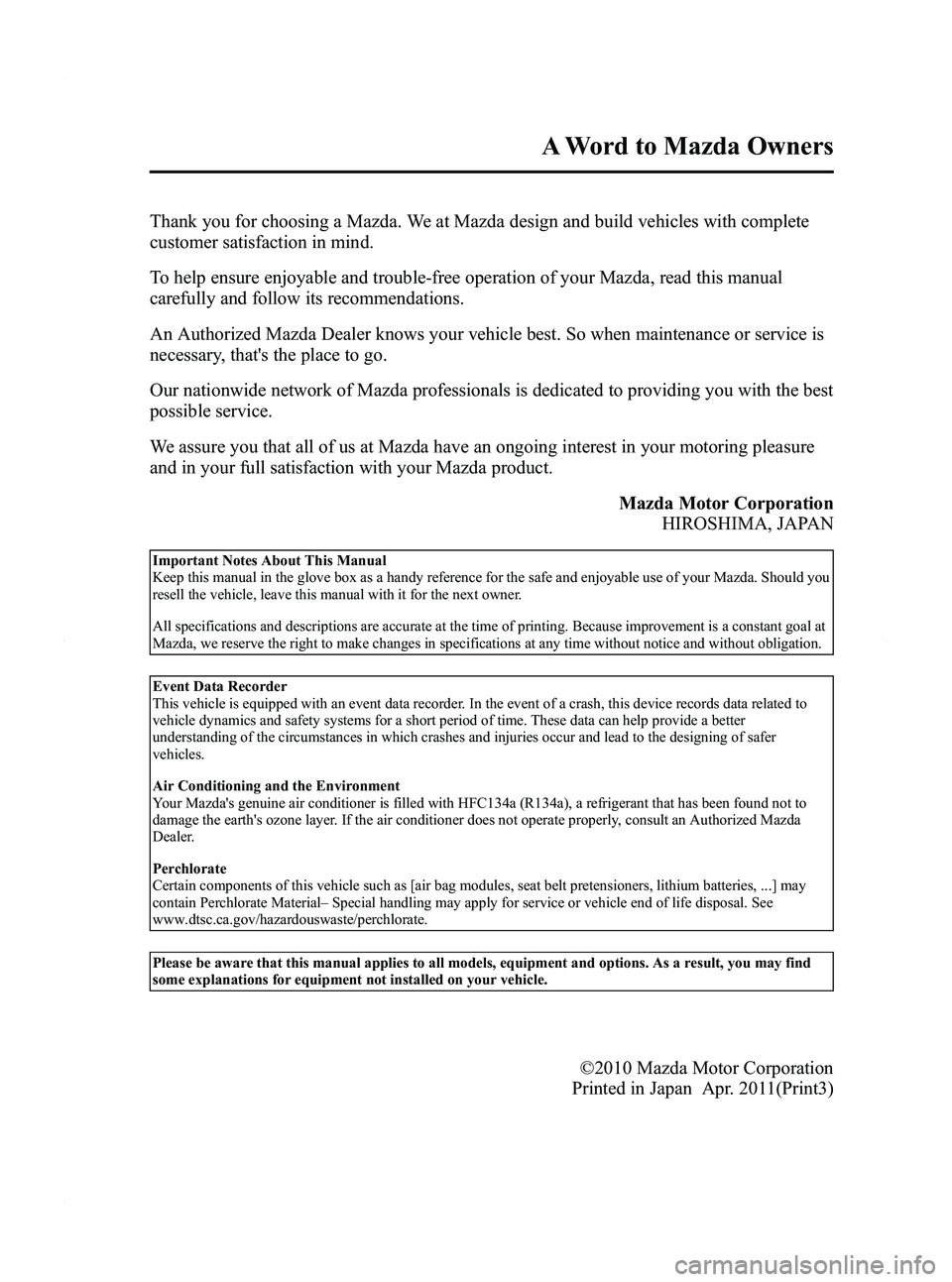
Black plate (3,1)
Thank you for choosing a Mazda. We at Mazda design and build vehicles with complete
customer satisfaction in mind.
To help ensure enjoyable and trouble-free operation of your Mazda, read this manual
carefully and follow its recommendations.
An Authorized Mazda Dealer knows your vehicle best. So when maintenance or service is
necessary, that's the place to go.
Our nationwide network of Mazda professionals is dedicated to providing you with the best
possible service.
We assure you that all of us at Mazda have an ongoing interest in your motoring pleasure
and in your full satisfaction with your Mazda product.Mazda Motor CorporationHIROSHIMA, JAPAN
Important Notes About This Manual
Keep this manual in the glove box as a handy reference for the safe and enjoyable use of your Mazda. Should you
resell the vehicle, leave this manual with it for the next owner.
All specifications and descriptions are accurate at the time of printing. Because improvement is a constant goal at
Mazda, we reserve the right to make changes in specifications at any time without notice and without obligation.
Event Data Recorder
This vehicle is equipped with an event data recorder. In the event of a crash, this device records data related to
vehicle dynamics and safety systems for a short period of time. These data can help provide a better
understanding of the circumstances in which crashes and injuries occur and lead to the designing of safer
vehicles.
Air Conditioning and the Environment
Your Mazda's genuine air conditioner is filled with HFC134a (R134a), a refrigerant that has been found not to
damage the earth's ozone layer. If the air conditioner does not operate properly, consult an Authorized Mazda
Dealer.
Perchlorate
Certain components of this vehicle such as [air bag modules, seat belt pretensioners, lithium batteries, ...] may
contain Perchlorate Material –Special handling may apply for service or vehicle end of life disposal. See
www.dtsc.ca.gov/hazardouswaste/perchlorate.
Please be aware that this manual applies to all models, equipment and options. As a result, you may find
some explanations for equipment not installed on your vehicle.
©2010 Mazda Motor Corporation
Printed in Japan Apr. 2011(Print3)
A Word to Mazda Owners
Mazda5_8BR9-EA-10J_Edition3 Page3
Monday, February 21 2011 1:43 PM
Form No.8BR9-EA-10J
Page 13 of 440
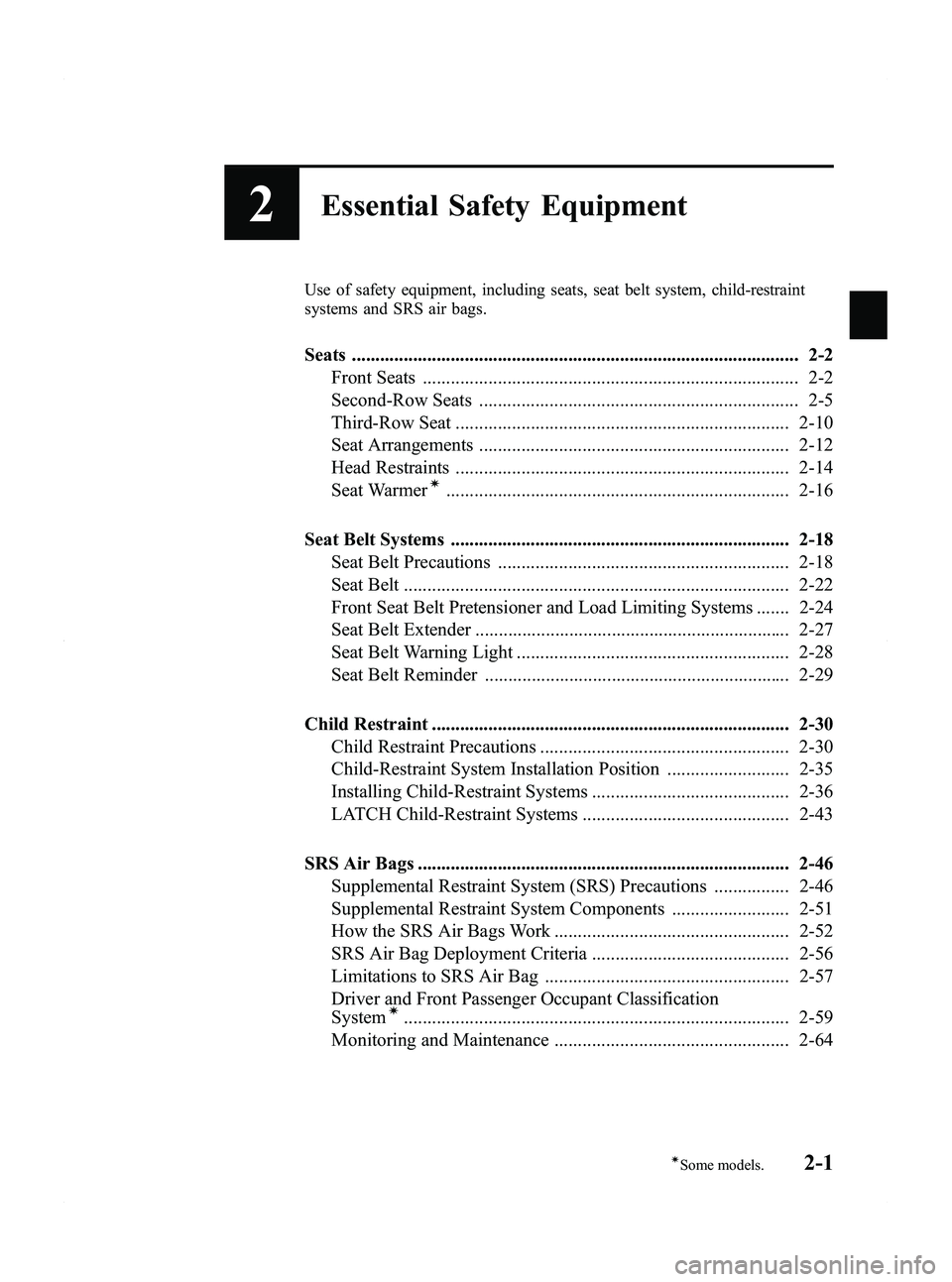
Black plate (13,1)
2Essential Safety Equipment
Use of safety equipment, including seats, seat belt system, child-restraint
systems and SRS air bags.
Seats ............................................................................................... 2-2Front Seats ................................................................................ 2-2
Second-Row Seats .................................................................... 2-5
Third-Row Seat ....................................................................... 2-10
Seat Arrangements .................................................................. 2-12
Head Restraints ....................................................................... 2-14
Seat Warmer
í......................................................................... 2-16
Seat Belt Systems ........................................................................ 2-18 Seat Belt Precautions .............................................................. 2-18
Seat Belt .................................................................................. 2-22
Front Seat Belt Pretensioner and Load Limiting Systems ....... 2-24
Seat Belt Extender ................................................................... 2-27
Seat Belt Warning Light .......................................................... 2-28
Seat Belt Reminder ................................................................. 2-29
Child Restraint ............................................................................ 2-30 Child Restraint Precautions ..................................................... 2-30
Child-Restraint System Installation Position .......................... 2-35
Installing Child-Restraint Systems .......................................... 2-36
LATCH Child-Restraint Systems ............................................ 2-43
SRS Air Bags ............................................................................... 2-46 Supplemental Restraint System (SRS) Precautions ................ 2-46
Supplemental Restraint System Components ......................... 2-51
How the SRS Air Bags Work .................................................. 2-52
SRS Air Bag Deployment Criteria .......................................... 2-56
Limitations to SRS Air Bag .................................................... 2-57
Driver and Front Passenger Occupant Classification
System
í.................................................................................. 2-59
Monitoring and Maintenance .................................................. 2-64
2-1íSome models.
Mazda5_8BR9-EA-10J_Edition3 Page13
Monday, February 21 2011 1:43 PM
Form No.8BR9-EA-10J
Page 28 of 440
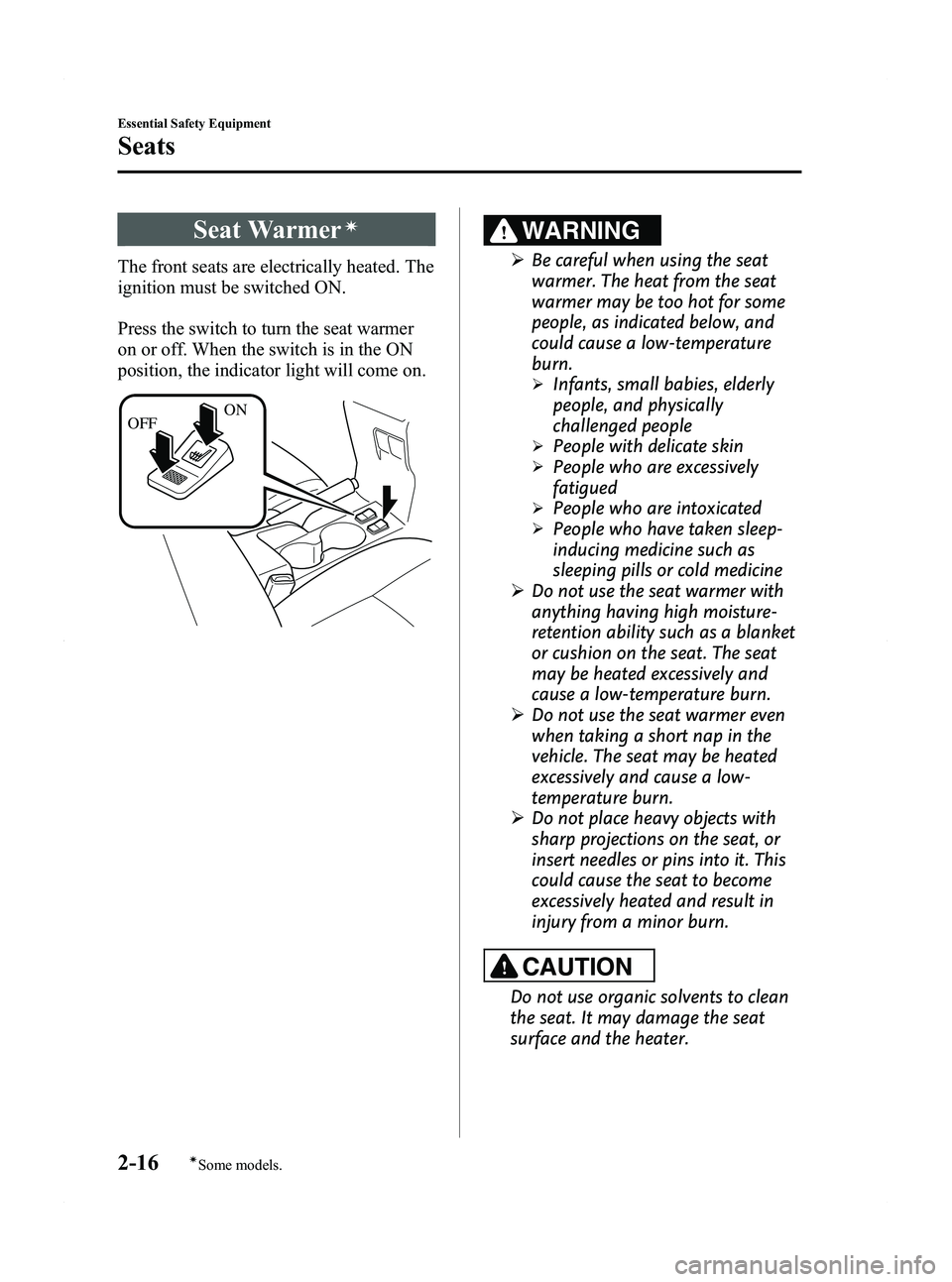
Black plate (28,1)
Seat Warmerí
The front seats are electrically heated. The
ignition must be switched ON.
Press the switch to turn the seat warmer
on or off. When the switch is in the ON
position, the indicator light will come on.
OFFON
WARNING
Ø
Be careful when using the seat
warmer. The heat from the seat
warmer may be too hot for some
people, as indicated below, and
could cause a low-temperature
burn.
ØInfants, small babies, elderly
people, and physically
challenged people
ØPeople with delicate skin
ØPeople who are excessively
fatigued
ØPeople who are intoxicated
ØPeople who have taken sleep-
inducing medicine such as
sleeping pills or cold medicine
Ø Do not use the seat warmer with
anything having high moisture-
retention ability such as a blanket
or cushion on the seat. The seat
may be heated excessively and
cause a low-temperature burn.
Ø Do not use the seat warmer even
when taking a short nap in the
vehicle. The seat may be heated
excessively and cause a low-
temperature burn.
Ø Do not place heavy objects with
sharp projections on the seat, or
insert needles or pins into it. This
could cause the seat to become
excessively heated and result in
injury from a minor burn.
CAUTION
Do not use organic solvents to clean
the seat. It may damage the seat
surface and the heater.
2-16
Essential Safety Equipment
íSome models.
Seats
Mazda5_8BR9-EA-10J_Edition3 Page28
Monday, February 21 2011 1:44 PM
Form No.8BR9-EA-10J
Page 30 of 440
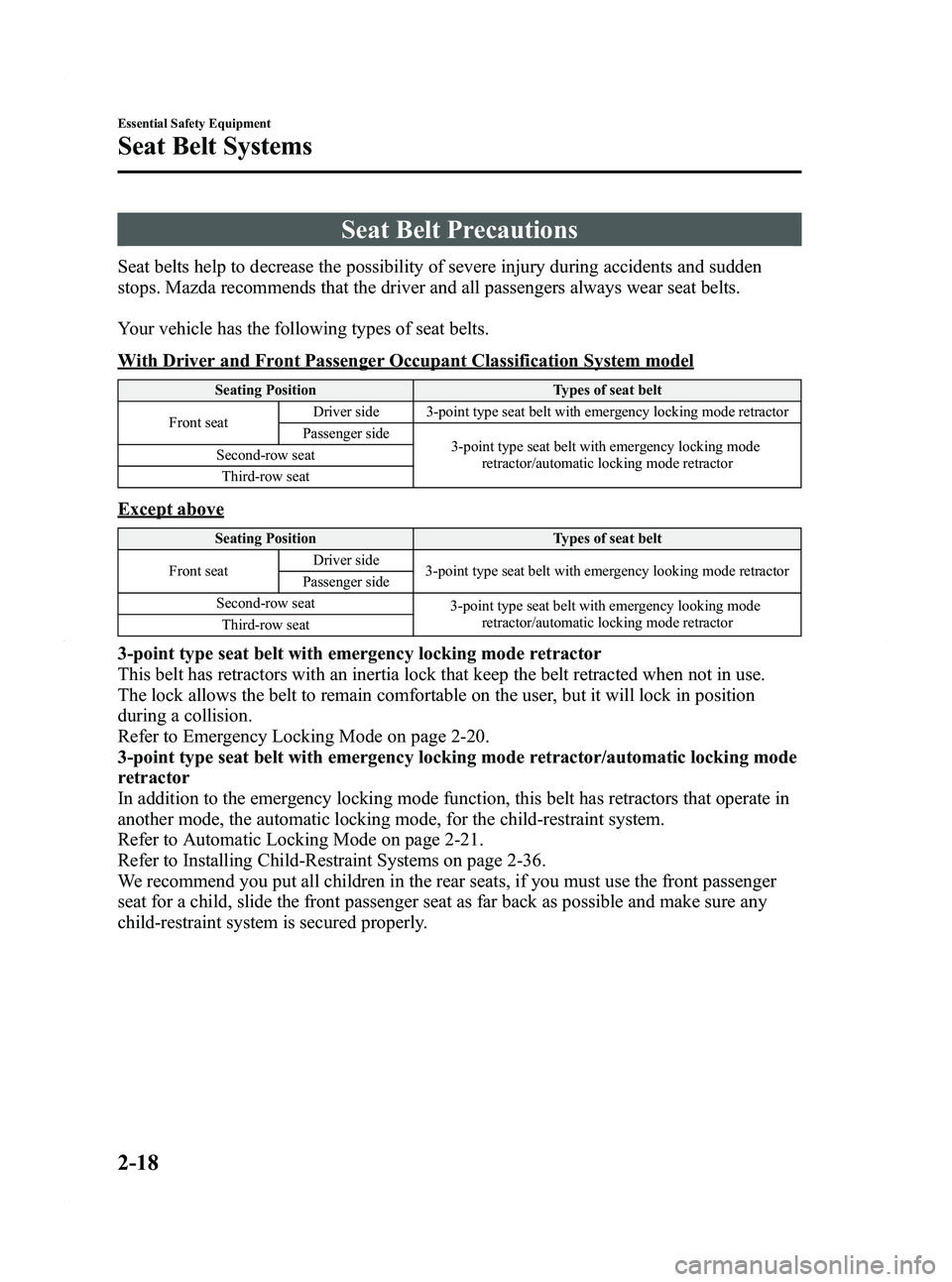
Black plate (30,1)
Seat Belt Precautions
Seat belts help to decrease the possibility of severe injury during accidents and sudden
stops. Mazda recommends that the driver and all passengers always wear seat belts.
Your vehicle has the following types of seat belts.
With Driver and Front Passenger Occupant Classification System model
Seating PositionTypes of seat belt
Front seat Driver side 3-point type seat belt with emergency locking mode retractor
Passenger side 3-point type seat belt with emergency locking mode
retractor/automatic locking mode retractor
Second-row seat
Third-row seat
Except above
Seating Position Types of seat belt
Front seat Driver side
3-point type seat belt with emergency looking mode retractor
Passenger side
Second-row seat 3-point type seat belt with emergency looking mode
retractor/automatic locking mode retractor
Third-row seat
3-point type seat belt with emergency locking mode retractor
This belt has retractors with an inertia lock that keep the belt retracted when not in use.
The lock allows the belt to remain comfortable on the user, but it will lock in position
during a collision.
Refer to Emergency Locking Mode on page 2-20.
3-point type seat belt with emergency locking mode retractor/automatic locking mode
retractor
In addition to the emergency locking mode function, this belt has retractors that operate in
another mode, the automatic locking mode, for the child-restraint system.
Refer to Automatic Locking Mode on page 2-21.
Refer to Installing Child-Restraint Systems on page 2-36.
We recommend you put all children in the rear seats, if you must use the front passenger
seat for a child, slide the front passenger seat as far back as possible and make sure any
child-restraint system is secured properly.
2-18
Essential Safety Equipment
Seat Belt Systems
Mazda5_8BR9-EA-10J_Edition3 Page30
Monday, February 21 2011 1:44 PM
Form No.8BR9-EA-10J
Page 32 of 440
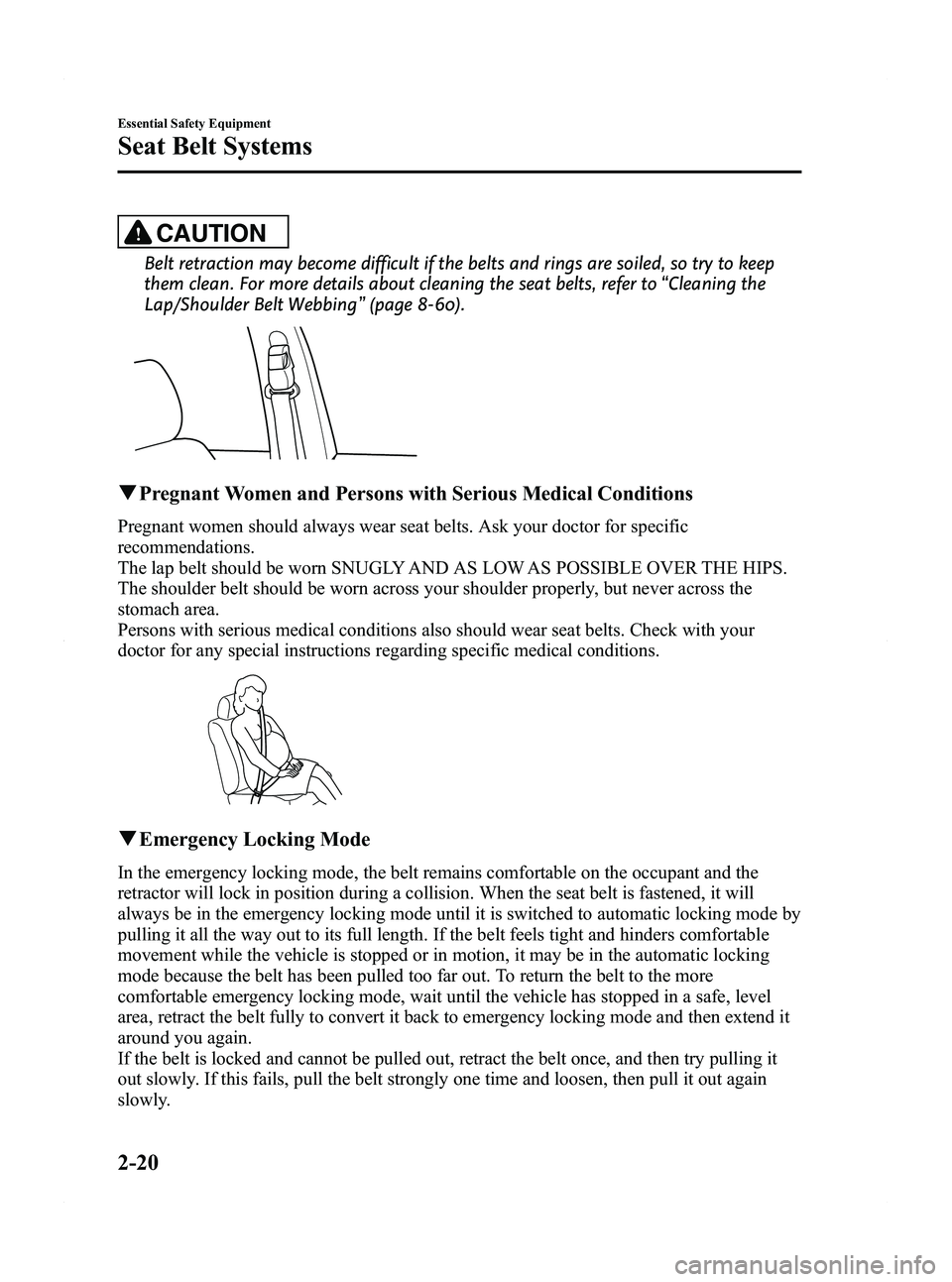
Black plate (32,1)
CAUTION
Belt retraction may become difficult if the belts and rings are soiled, so try to keep
them clean. For more details about cleaning the seat belts, refer to“Cleaning the
Lap/Shoulder Belt Webbing ”(page 8-60).
q Pregnant Women and Persons with Serious Medical Conditions
Pregnant women should always wear seat belts. Ask your doctor for specific
recommendations.
The lap belt should be worn SNUGLY AND AS LOW AS POSSIBLE OVER THE HIPS.
The shoulder belt should be worn across your shoulder properly, but never across the
stomach area.
Persons with serious medical conditions also should wear seat belts. Check with your
doctor for any special instructions regarding specific medical conditions.
qEmergency Locking Mode
In the emergency locking mode, the belt remains comfortable on the occupant and the
retractor will lock in position during a collision. When the seat belt is fastened, it will
always be in the emergency locking mode until it is switched to automatic locking mode by
pulling it all the way out to its full length. If the belt feels tight and hinders comfortable
movement while the vehicle is stopped or in motion, it may be in the automatic locking
mode because the belt has been pulled too far out. To return the belt to the more
comfortable emergency locking mode, wait until the vehicle has stopped in a safe, level
area, retract the belt fully to convert it back to emergency locking mode and then extend it
around you again.
If the belt is locked and cannot be pulled out, retract the belt once, and then try pulling it
out slowly. If this fails, pull the belt strongly one time and loosen, then pull it out again
slowly.
2-20
Essential Safety Equipment
Seat Belt Systems
Mazda5_8BR9-EA-10J_Edition3 Page32
Monday, February 21 2011 1:44 PM
Form No.8BR9-EA-10J
Page 36 of 440
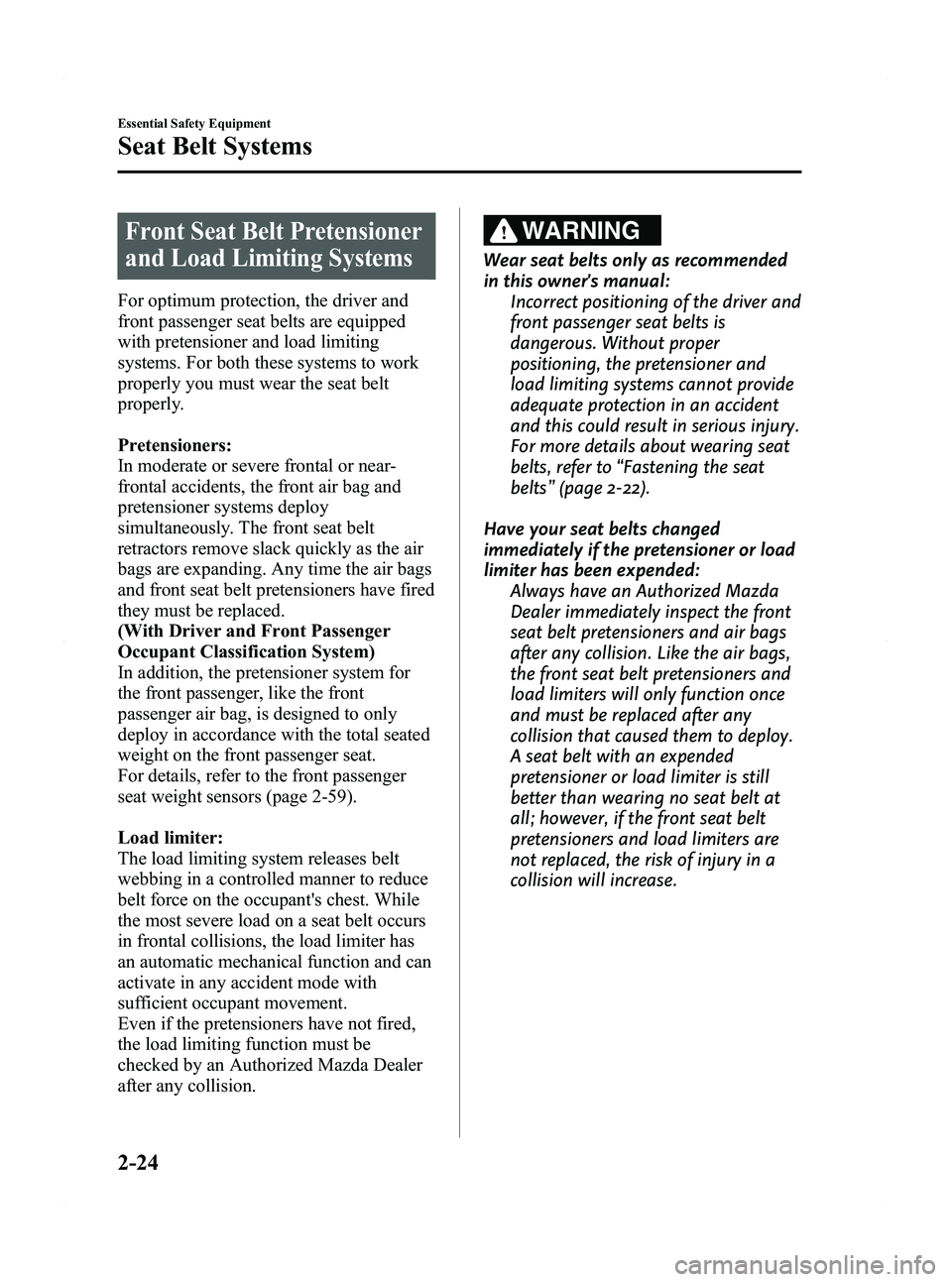
Black plate (36,1)
Front Seat Belt Pretensioner
and Load Limiting Systems
For optimum protection, the driver and
front passenger seat belts are equipped
with pretensioner and load limiting
systems. For both these systems to work
properly you must wear the seat belt
properly.
Pretensioners:
In moderate or severe frontal or near-
frontal accidents, the front air bag and
pretensioner systems deploy
simultaneously. The front seat belt
retractors remove slack quickly as the air
bags are expanding. Any time the air bags
and front seat belt pretensioners have fired
they must be replaced.
(With Driver and Front Passenger
Occupant Classification System)
In addition, the pretensioner system for
the front passenger, like the front
passenger air bag, is designed to only
deploy in accordance with the total seated
weight on the front passenger seat.
For details, refer to the front passenger
seat weight sensors (page 2-59).
Load limiter:
The load limiting system releases belt
webbing in a controlled manner to reduce
belt force on the occupant's chest. While
the most severe load on a seat belt occurs
in frontal collisions, the load limiter has
an automatic mechanical function and can
activate in any accident mode with
sufficient occupant movement.
Even if the pretensioners have not fired,
the load limiting function must be
checked by an Authorized Mazda Dealer
after any collision.
WARNING
Wear seat belts only as recommended
in this owner's manual:Incorrect positioning of the driver and
front passenger seat belts is
dangerous. Without proper
positioning, the pretensioner and
load limiting systems cannot provide
adequate protection in an accident
and this could result in serious injury.
For more details about wearing seat
belts, refer to “Fastening the seat
belts ”(page 2-22).
Have your seat belts changed
immediately if the pretensioner or load
limiter has been expended: Always have an Authorized Mazda
Dealer immediately inspect the front
seat belt pretensioners and air bags
after any collision. Like the air bags,
the front seat belt pretensioners and
load limiters will only function once
and must be replaced after any
collision that caused them to deploy.
A seat belt with an expended
pretensioner or load limiter is still
better than wearing no seat belt at
all; however, if the front seat belt
pretensioners and load limiters are
not replaced, the risk of injury in a
collision will increase.
2-24
Essential Safety Equipment
Seat Belt Systems
Mazda5_8BR9-EA-10J_Edition3 Page36
Monday, February 21 2011 1:44 PM
Form No.8BR9-EA-10J
Page 41 of 440
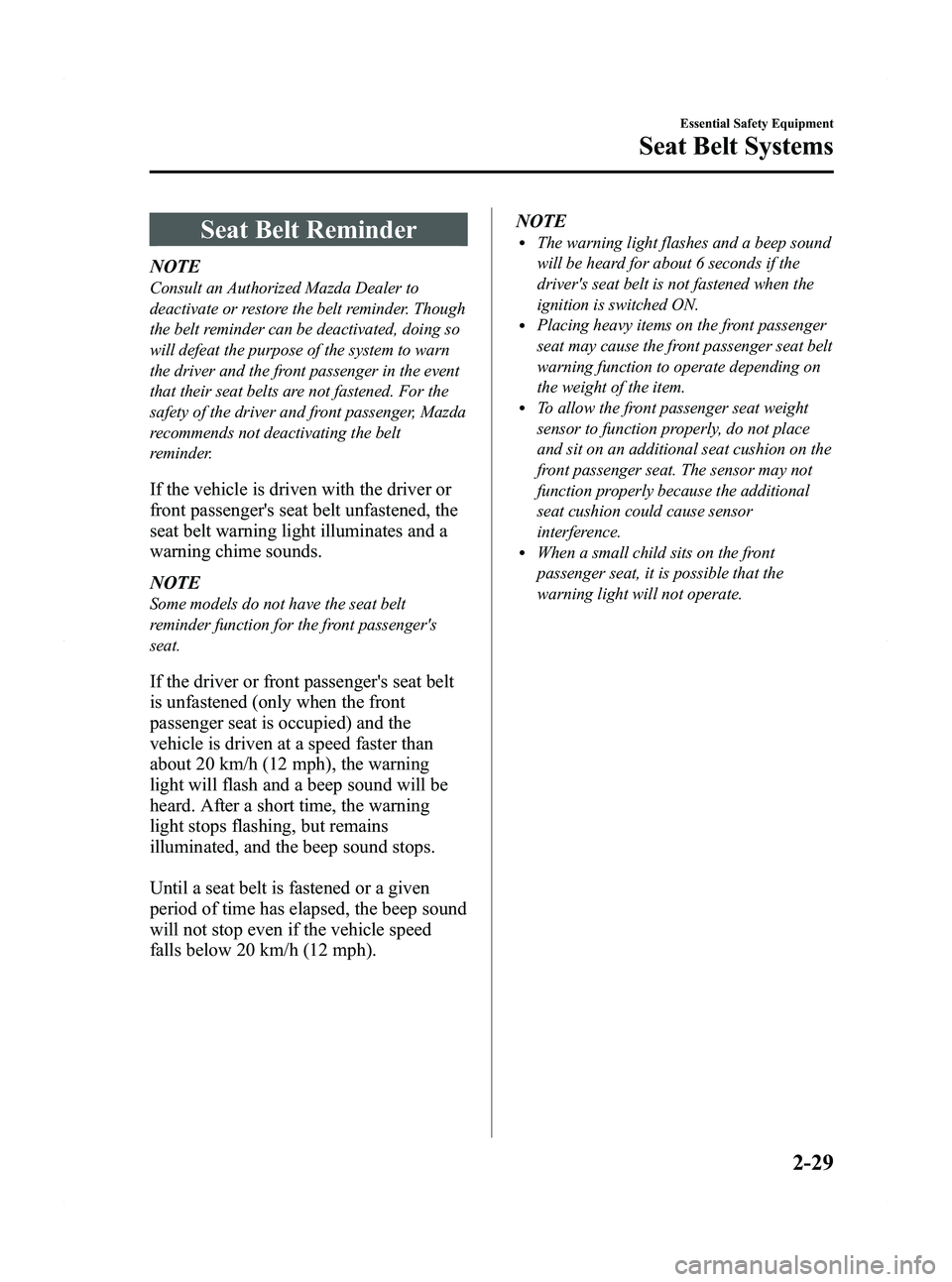
Black plate (41,1)
Seat Belt Reminder
NOTE
Consult an Authorized Mazda Dealer to
deactivate or restore the belt reminder. Though
the belt reminder can be deactivated, doing so
will defeat the purpose of the system to warn
the driver and the front passenger in the event
that their seat belts are not fastened. For the
safety of the driver and front passenger, Mazda
recommends not deactivating the belt
reminder.
If the vehicle is driven with the driver or
front passenger's seat belt unfastened, the
seat belt warning light illuminates and a
warning chime sounds.
NOTE
Some models do not have the seat belt
reminder function for the front passenger's
seat.
If the driver or front passenger's seat belt
is unfastened (only when the front
passenger seat is occupied) and the
vehicle is driven at a speed faster than
about 20 km/h (12 mph), the warning
light will flash and a beep sound will be
heard. After a short time, the warning
light stops flashing, but remains
illuminated, and the beep sound stops.
Until a seat belt is fastened or a given
period of time has elapsed, the beep sound
will not stop even if the vehicle speed
falls below 20 km/h (12 mph).NOTE
lThe warning light flashes and a beep sound
will be heard for about 6 seconds if the
driver's seat belt is not fastened when the
ignition is switched ON.
lPlacing heavy items on the front passenger
seat may cause the front passenger seat belt
warning function to operate depending on
the weight of the item.
lTo allow the front passenger seat weight
sensor to function properly, do not place
and sit on an additional seat cushion on the
front passenger seat. The sensor may not
function properly because the additional
seat cushion could cause sensor
interference.
lWhen a small child sits on the front
passenger seat, it is possible that the
warning light will not operate.
Essential Safety Equipment
Seat Belt Systems
2-29
Mazda5_8BR9-EA-10J_Edition3 Page41
Monday, February 21 2011 1:44 PM
Form No.8BR9-EA-10J
Page 48 of 440
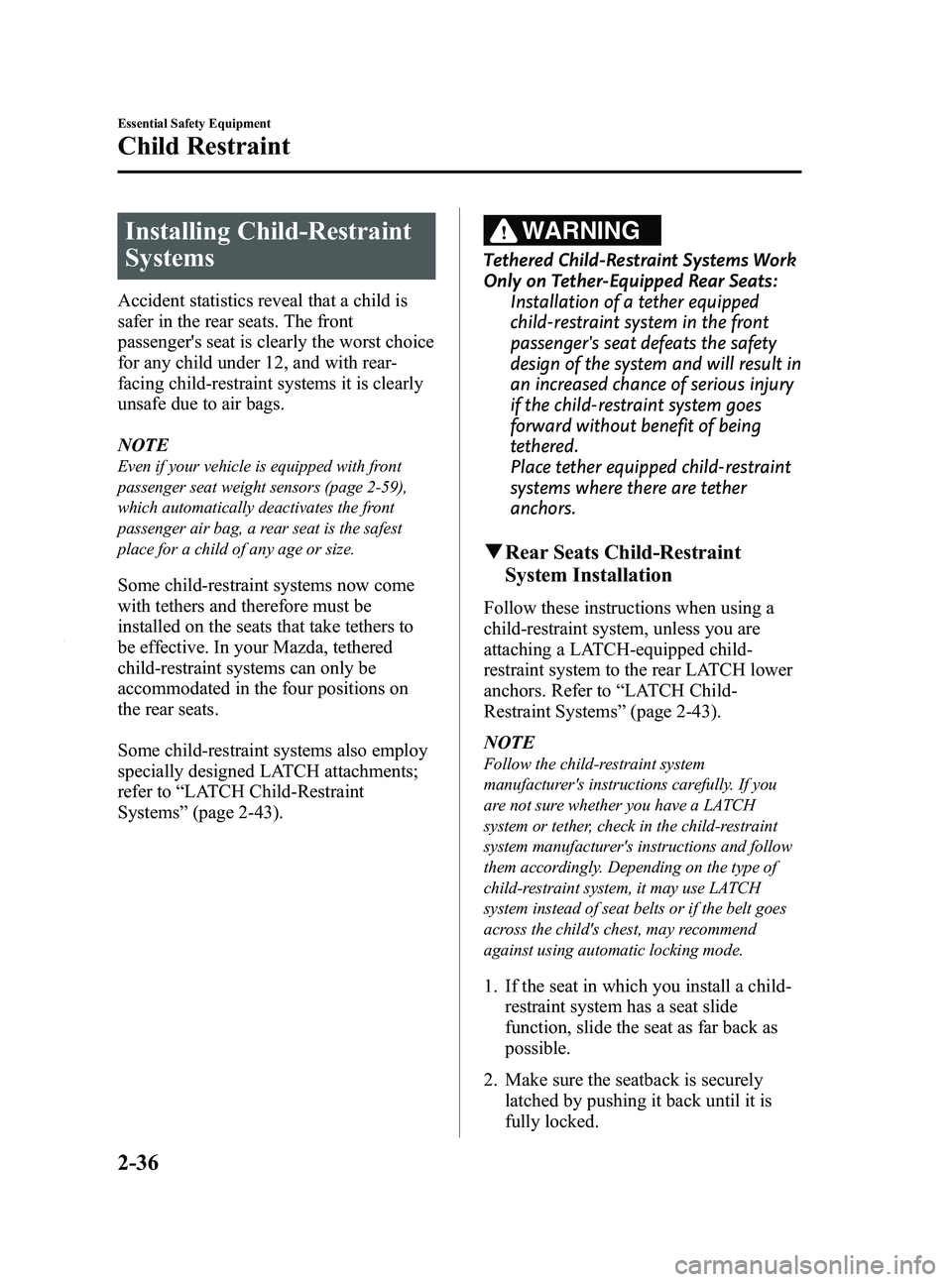
Black plate (48,1)
Installing Child-Restraint
Systems
Accident statistics reveal that a child is
safer in the rear seats. The front
passenger's seat is clearly the worst choice
for any child under 12, and with rear-
facing child-restraint systems it is clearly
unsafe due to air bags.
NOTE
Even if your vehicle is equipped with front
passenger seat weight sensors (page 2-59),
which automatically deactivates the front
passenger air bag, a rear seat is the safest
place for a child of any age or size.
Some child-restraint systems now come
with tethers and therefore must be
installed on the seats that take tethers to
be effective. In your Mazda, tethered
child-restraint systems can only be
accommodated in the four positions on
the rear seats.
Some child-restraint systems also employ
specially designed LATCH attachments;
refer to“LATCH Child-Restraint
Systems ”(page 2-43).
WARNING
Tethered Child-Restraint Systems Work
Only on Tether-Equipped Rear Seats:
Installation of a tether equipped
child-restraint system in the front
passenger's seat defeats the safety
design of the system and will result in
an increased chance of serious injury
if the child-restraint system goes
forward without benefit of being
tethered.
Place tether equipped child-restraint
systems where there are tether
anchors.
qRear Seats Child-Restraint
System Installation
Follow these instructions when using a
child-restraint system, unless you are
attaching a LATCH-equipped child-
restraint system to the rear LATCH lower
anchors. Refer to “LATCH Child-
Restraint Systems ”(page 2-43).
NOTE
Follow the child-restraint system
manufacturer's instructions carefully. If you
are not sure whether you have a LATCH
system or tether, check in the child-restraint
system manufacturer's instructions and follow
them accordingly. Depending on the type of
child-restraint system, it may use LATCH
system instead of seat belts or if the belt goes
across the child's chest, may recommend
against using automatic locking mode.
1. If the seat in which you install a child- restraint system has a seat slide
function, slide the seat as far back as
possible.
2. Make sure the seatback is securely latched by pushing it back until it is
fully locked.
2-36
Essential Safety Equipment
Child Restraint
Mazda5_8BR9-EA-10J_Edition3 Page48
Monday, February 21 2011 1:44 PM
Form No.8BR9-EA-10J
Page 49 of 440
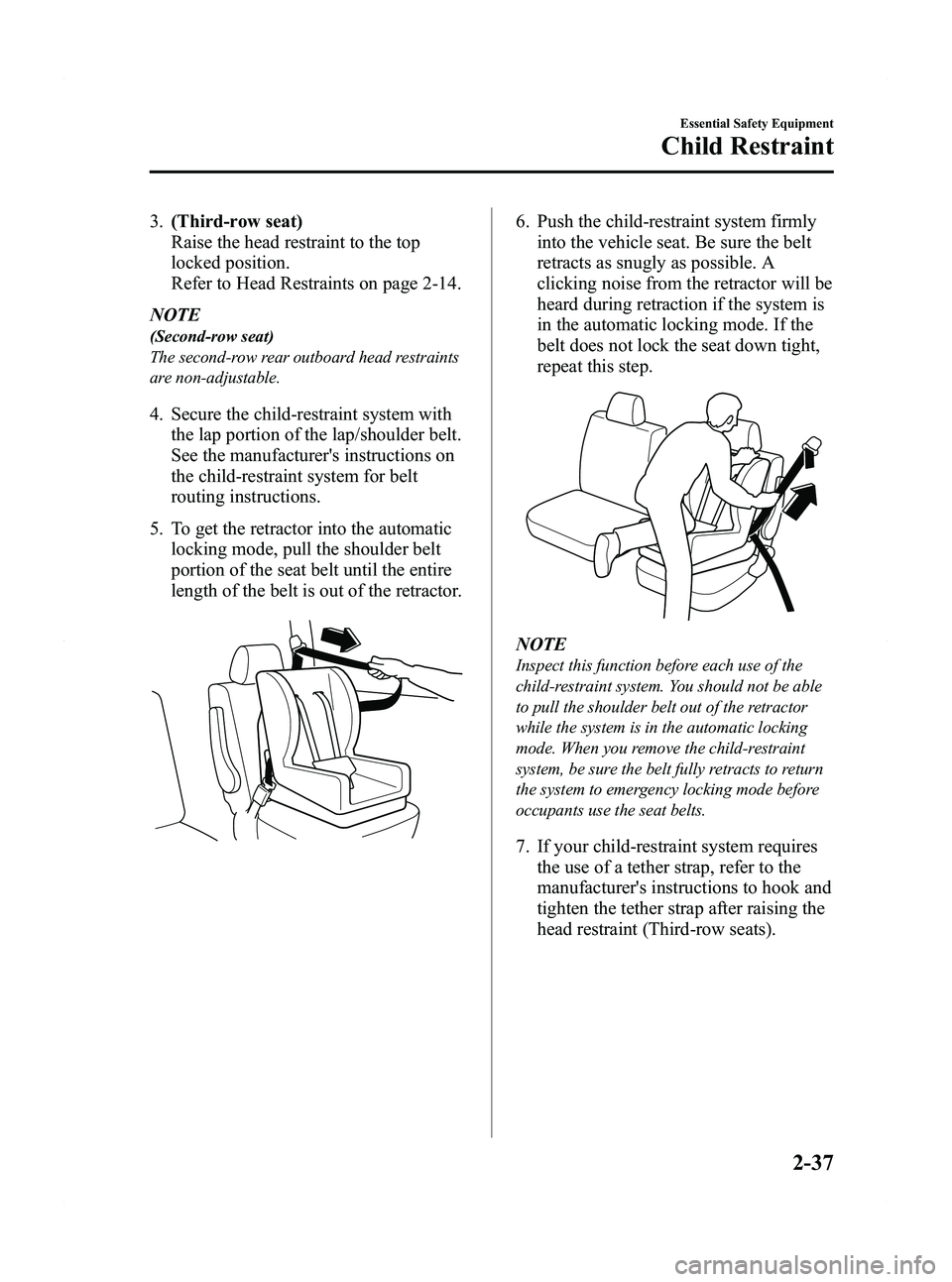
Black plate (49,1)
3.(Third-row seat)
Raise the head restraint to the top
locked position.
Refer to Head Restraints on page 2-14.
NOTE
(Second-row seat)
The second-row rear outboard head restraints
are non-adjustable.
4. Secure the child-restraint system with the lap portion of the lap/shoulder belt.
See the manufacturer's instructions on
the child-restraint system for belt
routing instructions.
5. To get the retractor into the automatic locking mode, pull the shoulder belt
portion of the seat belt until the entire
length of the belt is out of the retractor.
6. Push the child-restraint system firmlyinto the vehicle seat. Be sure the belt
retracts as snugly as possible. A
clicking noise from the retractor will be
heard during retraction if the system is
in the automatic locking mode. If the
belt does not lock the seat down tight,
repeat this step.
NOTE
Inspect this function before each use of the
child-restraint system. You should not be able
to pull the shoulder belt out of the retractor
while the system is in the automatic locking
mode. When you remove the child-restraint
system, be sure the belt fully retracts to return
the system to emergency locking mode before
occupants use the seat belts.
7. If your child-restraint system requiresthe use of a tether strap, refer to the
manufacturer's instructions to hook and
tighten the tether strap after raising the
head restraint (Third-row seats).
Essential Safety Equipment
Child Restraint
2-37
Mazda5_8BR9-EA-10J_Edition3 Page49
Monday, February 21 2011 1:44 PM
Form No.8BR9-EA-10J
Page 51 of 440
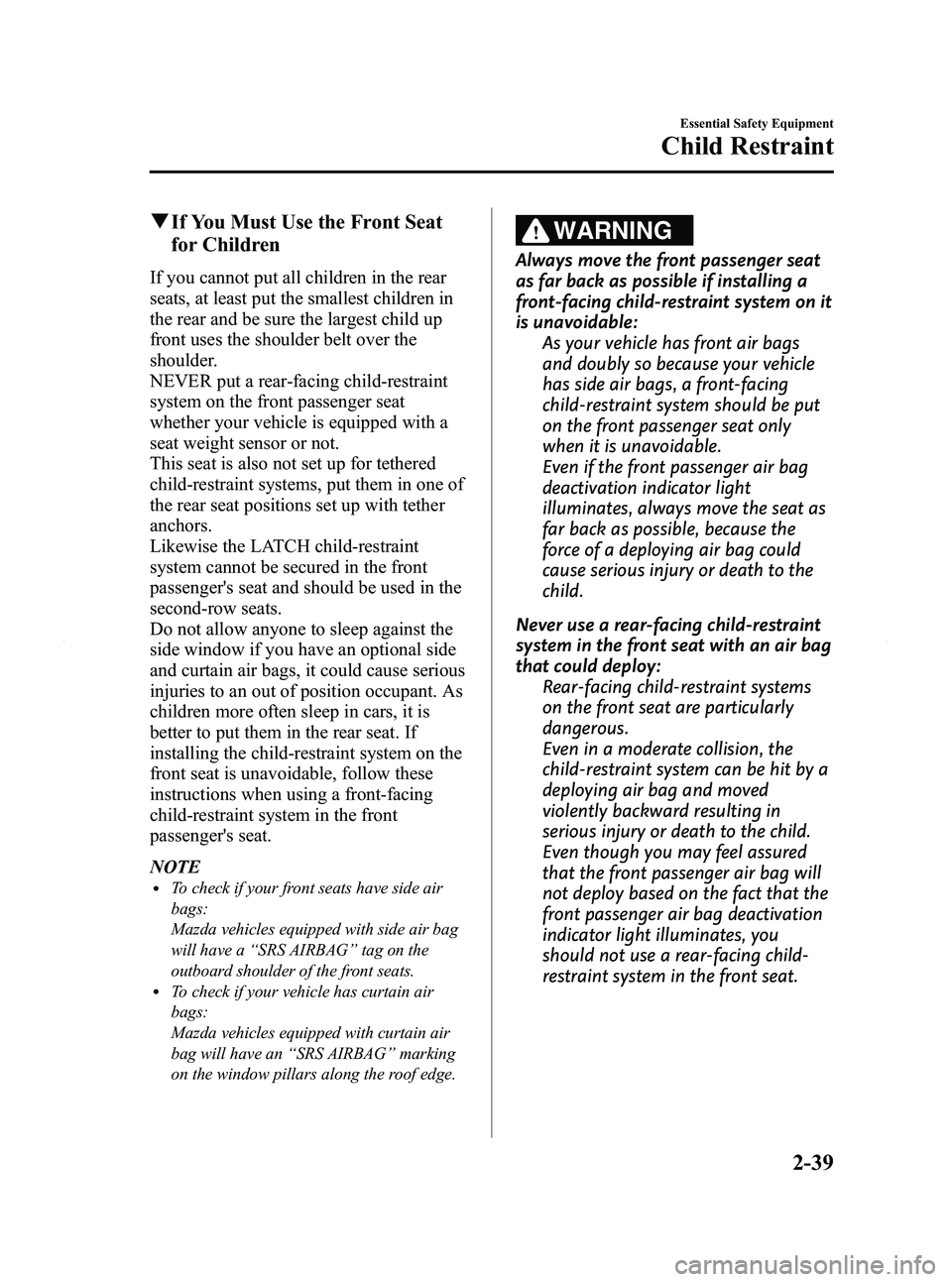
Black plate (51,1)
qIf You Must Use the Front Seat
for Children
If you cannot put all children in the rear
seats, at least put the smallest children in
the rear and be sure the largest child up
front uses the shoulder belt over the
shoulder.
NEVER put a rear-facing child-restraint
system on the front passenger seat
whether your vehicle is equipped with a
seat weight sensor or not.
This seat is also not set up for tethered
child-restraint systems, put them in one of
the rear seat positions set up with tether
anchors.
Likewise the LATCH child-restraint
system cannot be secured in the front
passenger's seat and should be used in the
second-row seats.
Do not allow anyone to sleep against the
side window if you have an optional side
and curtain air bags, it could cause serious
injuries to an out of position occupant. As
children more often sleep in cars, it is
better to put them in the rear seat. If
installing the child-restraint system on the
front seat is unavoidable, follow these
instructions when using a front-facing
child-restraint system in the front
passenger's seat.
NOTE
lTo check if your front seats have side air
bags:
Mazda vehicles equipped with side air bag
will have a “SRS AIRBAG ”tag on the
outboard shoulder of the front seats.
lTo check if your vehicle has curtain air
bags:
Mazda vehicles equipped with curtain air
bag will have an “SRS AIRBAG ”marking
on the window pillars along the roof edge.
WARNING
Always move the front passenger seat
as far back as possible if installing a
front-facing child-restraint system on it
is unavoidable: As your vehicle has front air bags
and doubly so because your vehicle
has side air bags, a front-facing
child-restraint system should be put
on the front passenger seat only
when it is unavoidable.
Even if the front passenger air bag
deactivation indicator light
illuminates, always move the seat as
far back as possible, because the
force of a deploying air bag could
cause serious injury or death to the
child.
Never use a rear-facing child-restraint
system in the front seat with an air bag
that could deploy: Rear-facing child-restraint systems
on the front seat are particularly
dangerous.
Even in a moderate collision, the
child-restraint system can be hit by a
deploying air bag and moved
violently backward resulting in
serious injury or death to the child.
Even though you may feel assured
that the front passenger air bag will
not deploy based on the fact that the
front passenger air bag deactivation
indicator light illuminates, you
should not use a rear-facing child-
restraint system in the front seat.
Essential Safety Equipment
Child Restraint
2-39
Mazda5_8BR9-EA-10J_Edition3 Page51
Monday, February 21 2011 1:44 PM
Form No.8BR9-EA-10J